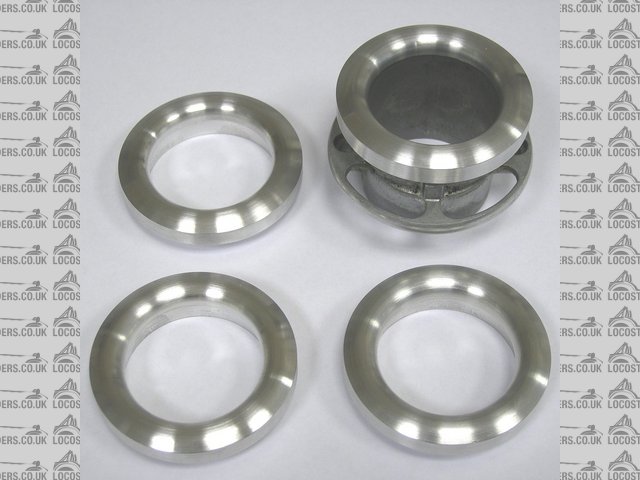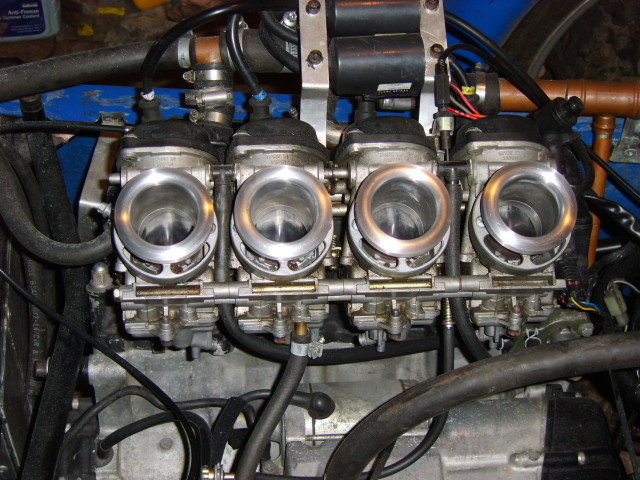smart51
|
| posted on 30/1/07 at 02:22 PM |

|
|
carb bellmouths
Look what I've just had delivered: nice shiny new bell mouths for my carbs. An engineering article I read suggests that a radiused inlet flows
15% more air than a plain pipe, though of course the carb inlet is not the only flow restriction on an engine inlet. What do you think?
 
Rescued attachment bellmouth_small.JPG
|
|
|
|
|
02GF74
|
| posted on 30/1/07 at 03:08 PM |

|
|
one of them is different 
|
|
|
smart51
|
| posted on 30/1/07 at 03:15 PM |

|
|
Is that the one that is fitted to the carb boss? The other 3 bosses are still fitted to the carbs. The latheist only needed one to measure up. The other 3 bosses are still fitted to the carbs. The latheist only needed one to measure up.
|
|
|
daviep
|
| posted on 30/1/07 at 03:40 PM |

|
|
Is a latheist similar to a turner? 
|
|
|
TimC
|
| posted on 30/1/07 at 04:14 PM |

|
|
How much?
|
|
|
smart51
|
| posted on 30/1/07 at 04:18 PM |

|
|
quote:
Originally posted by TimC
How much?
4" of 2.5" aluminium round bar from the metal supermarket: £9.25
Time of a friendly lathest (he's much better than a mere turner ): free ): free
|
|
|
coozer
|
| posted on 30/1/07 at 04:21 PM |

|
|
They do look a little bit short? Different lengths??
1972 V8 Jago
1980 Z750
|
|
|
TimC
|
| posted on 30/1/07 at 05:50 PM |

|
|
quote:
Originally posted by smart51
quote:
Originally posted by TimC
How much?
4" of 2.5" aluminium round bar from the metal supermarket: £9.25
Time of a friendly lathest (he's much better than a mere turner ): free ): free
Ok then Col.
What are you selling them for? 
|
|
|
smart51
|
| posted on 30/1/07 at 06:05 PM |

|
|
The shortness of the trumpet makes no difference, its the radius that helps the airflow. They are all the same size though. The length of the whole
inlet tract decides what at RPM best breathing is. By removing the long rubber trumpets off the R1, you raise that by 500 RPM from 8000 to 8500 (or
8500 to 9000 I can't remember). It's not a problem, especially as I was running with out the rubber trumpets at all before. Oh, and Tim,
they're not for sale.
Here's a picture of them fitted
 
Rescued attachment carb bellmouths.JPG
|
|
|
roadrunner
|
| posted on 30/1/07 at 07:09 PM |

|
|
They do look nice , but, acording to a recent thread, a change in length of said trumpets, alters where the torque comes in, i think.
|
|
|
smart51
|
| posted on 31/1/07 at 07:32 PM |

|
|
I've just taken the car for a short drive. The trumpetshave made a noticable difference at higher revs.
With my experimental airbox fitted, it was starting to bog down at the top end. Raising the airbox lid from the carbs improved it a bit and fitting
the bellmouths has almost cured it. I suspect the box was causing some restriction in airflow at high revs, causing the air pressure to drop and
therefore the mixture to get too rich. Fitting the bellmouths would seem to improve top end airflow then.
|
|
|
bike_power
|
| posted on 31/1/07 at 09:05 PM |

|
|
Bells make a huge difference to not just air flow but also helps even out the distribution of air amongst the inlets if the airbox isn't
perfect, which pretty much none are. Won't cure a major design defect but will help.
Those look very nice 
|
|
|
smart51
|
| posted on 22/2/07 at 10:37 PM |

|
|
Just as a test, I fitted the old foam filter instead of the airbox and did a test run, then added the trumpets and did another. The engine leaned
right out above 8000 RPM in all gears with the trumpets. I guess they really do add extra airflow. I'm tempted to dump the airbox and rejet
extra fuel to match the extra air. More power or less noise, Hmmm?
|
|
|
DIY Si
|
| posted on 22/2/07 at 11:09 PM |

|
|
It can be quite shocking how much extra flow a good set of bellmouths can add, something like up to 10(ish)% over a square ended opening. It might be
worth getting it on a rolling road to see just how much power they give and decide if it's worth the extra noise.
“Let your plans be dark and as impenetratable as night, and when you move, fall like a thunderbolt.”
Sun Tzu, The Art of War
My new blog: http://spritecave.blogspot.co.uk/
|
|
|
dilley
|
| posted on 22/2/07 at 11:14 PM |

|
|
Is this the case with forced induction?
|
|
|
Coose
|
| posted on 23/2/07 at 08:15 AM |

|
|
quote:
Originally posted by dilley
Is this the case with forced induction?
No. You don't really need to worry about air inlet profiles as the air charge is under pressure and will find its' way in to where it
needs to be!
Spin 'er off Well...
|
|
|
bike_power
|
| posted on 23/2/07 at 08:26 PM |

|
|
quote:
Originally posted by Coose
quote:
Originally posted by dilley
Is this the case with forced induction?
No. You don't really need to worry about air inlet profiles as the air charge is under pressure and will find its' way in to where it
needs to be!
Ummmm ...like any fluid system if you have sharp edges which make air or liquid change direction you'll get turbulance, if you smooth out the
air flow then the turbulance will be reduced, so you get better flow.
If you look for example, at the Cossie 4x4 (and probably 2wd) intercooler, the inlet and outlet pipes are just let in on a flat face so when the air
is flowing through the core, it hits the end and turns right, but the outlet is a plate with a pipe in it, so you get turbulance where the air bunches
up on the plate and then is squeezed down the pipe.
If the air flow was very low then it wouldn't matter but where air flow is high, such as a plenum chamber, things like a radiused pipe can makea
big difference.
|
|
|
Coose
|
| posted on 25/2/07 at 12:12 AM |

|
|
That certainly applies with a normally aspirated motor, but with forced induction it's nowhere near as critical due to the fact that the charge
is being pushed through the manifold into the cylinders rather than being drawn.
In a forced induction installation, all the engine sees when the valves open is a charge under pressure, which allows greater filling of the cylinders
(hence the increase in power on a turbo/supercharged motor). The cylinder isn't concerned at how the charge arrived at the inlet valve.
A normally aspirated engine is a different entity - the piston is required to pull the charge into the cylinder once the valve opens. Therefore, any
assistance that's available to get the charge into the cylinder easier (such as radiused manifolds, bellmouths etc.) is a massive bonus.
Spin 'er off Well...
|
|
|
bike_power
|
| posted on 25/2/07 at 09:05 AM |

|
|
I hear what you're saying but with forced induction there is more air being ingested by the engine so any turbulance will be greater. What on a
n/a motor may cost you 8 bhp will cost you 12 bhp on a forced induction motor because there's more air trying to flow down the tube.
It's not critical and doesn't worry most poeple, but if you give away 5 bhp here, 12 bhp there, you eventually end up being 40 bhp down on
where you wanted to be, or the boost gets turned up to compansate and then more heat is generated etc, it's all the small things that are
free/cheap that make the difference.
|
|
|
DIY Si
|
| posted on 26/2/07 at 04:50 PM |

|
|
You're both correct. Yes it makes a difference, but not as big on a forced induction. Increased flow is increased flow, which means more power,
regardless of the induction system used. However, some turbo systems used to have log manifolds to increase turbulence, but that was mainly to stop
the fuel falling out the air. Sometimes a smooth low is not the best answer.
“Let your plans be dark and as impenetratable as night, and when you move, fall like a thunderbolt.”
Sun Tzu, The Art of War
My new blog: http://spritecave.blogspot.co.uk/
|
|
|













